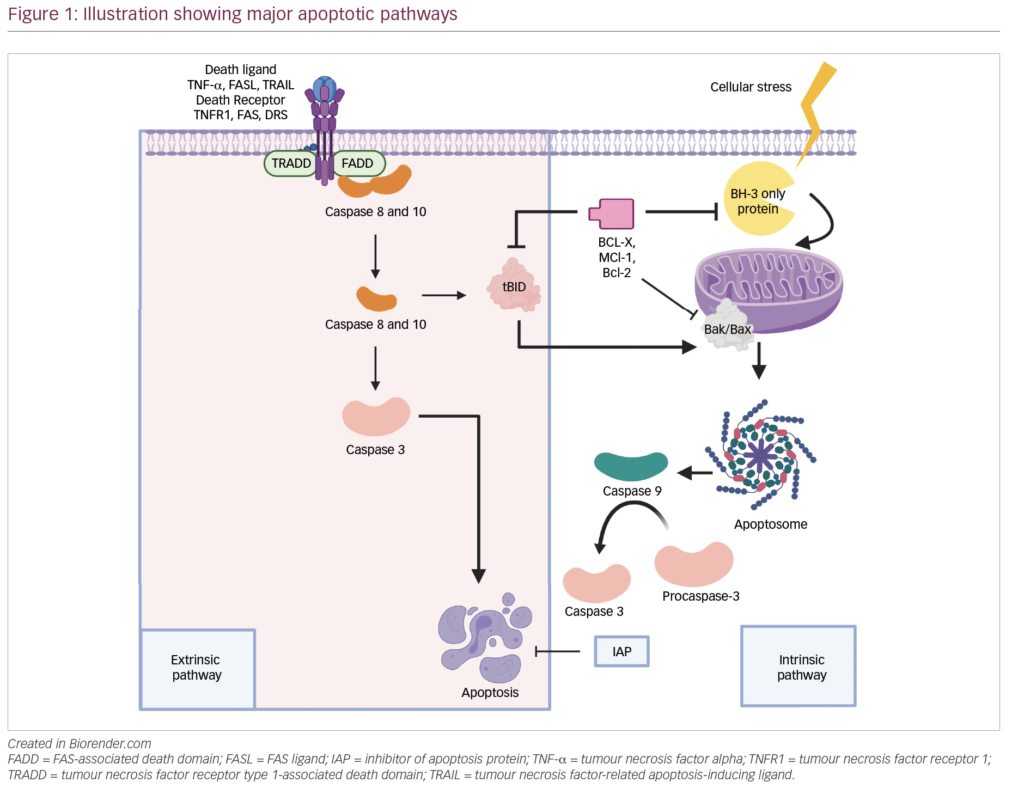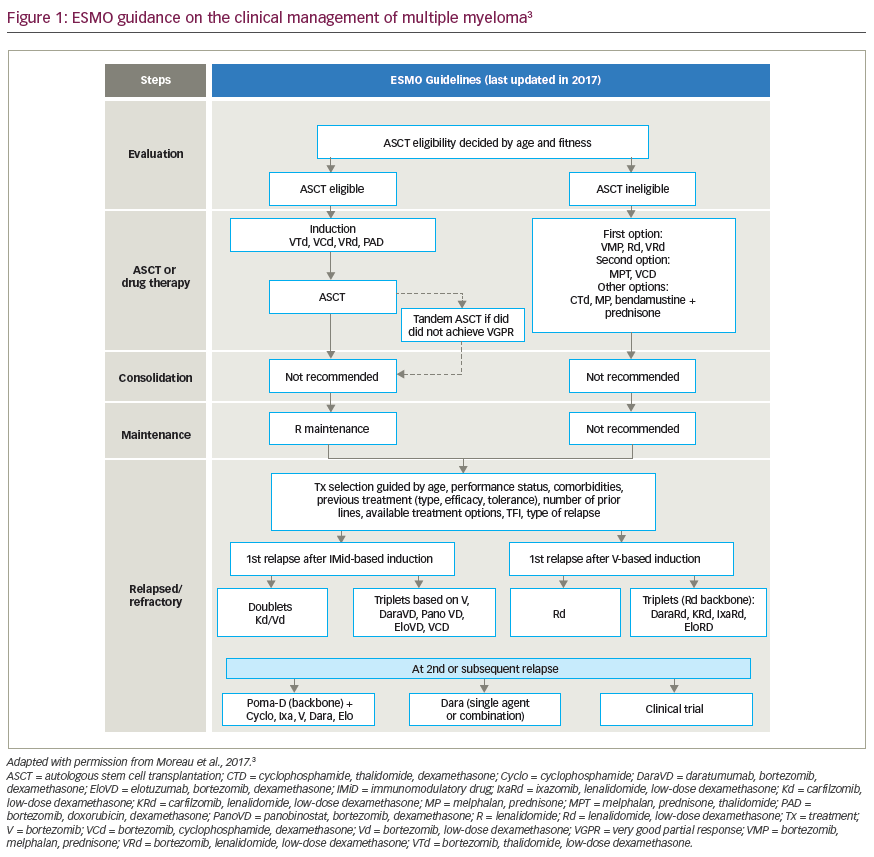Multiple myeloma (MM) is an incurable plasma cell disease that comprises 1 % of all cancers and 10 % of hematologic malignancies. It primarily affects older individuals—the median age at the moment of diagnosis is 70 years—and two-thirds of multiple myeloma patients are over 65 years of age when they are first diagnosed. The outcome of MM patients has significantly improved in the last decade.1,2 However, the main benefit has accrued to young patients, due to the introduction of high-dose therapy followed by autologous stem cell transplantation (HDT-ASCT) that are upfront and novel agents as rescue therapy, while only a marginal change has been observed in patients older than 65 years. However, the availability of new frontline treatment regimens based on the novel agents thalidomide, bortezomib, and lenalidomide has extended the options for transplant-ineligible MM patients.
In parallel with the advances in treatment options, goals of therapy have also evolved for non-transplant candidate patients. While prolongation of disease-free and overall survival remain the ultimate goal, to achieve prolonged treatment-free intervals and good quality of life also become important aims. Moreover, in the era of melphalan plus prednisone (MP), the goal was to achieve partial response (PR); by contrast, nowadays with the new agents, complete response (CR) has become the new goal also in elderly patients. Thus, in a retrospective analysis on pooled data of 1,175 patients with newly diagnosed MM, treated with MP and novel agents, the achievement of CR was associated with improved progressionfree survival (PFS) and overall survival (OS): the 3-year PFS was 67 % in patients who achieved CR versus 27 % in those in very good PR (VGPR) or PR, whereas the 3-year OS rates were 91 % in patients who obtained CR and 67 % to 70 % in those in VGPR or PR.3 Moreover, upon using more sensitive parameters, such as free-light chain and multiparameter flow cytometry, to define the depth of response, a Spanish group has shown, in a prospective analysis conducted in elderly patients receiving novel agents, that to achieve immunophenotypic response translated into superior PFS and OS compared with the presence of minimal residual disease after induction.4
Therefore, to monitor treatment efficacy with highly sensitive techniques should also be an objective in the treatment of elderly patients, sincethis could help clinicians to define the optimal level of response and to individualize treatment intensity and duration, with an appropriate balance with toxicity.
This review will provide a summary of data supporting the current management of elderly patients with newly diagnosed MM. The second generation of novel agents will be also evaluated. The potential role of maintenance/continuous treatment, as well as how to choose the best option of therapy for an optimized disease control, are also discussed.
Induction Regimens
Classic Combinations
Melphalan was the first active alkylating agent used for the treatment of MM patients, and MP was the standard of care for over 30 years, although it yielded only PR in 40–60 % of patients, with <5 % of CRs, and a PFS of approximately 18 months and OS of 2–3 years.5 With the introductionof novel agents, new combinations based on alkylating agents have been tested and compared with MP.
Bendamustine has been incorporated into the treatment armamentarium of MM, as the rebirth of an old drug. It has structural similarities to both alkylating agents and purine analogs and it is currently approved for the treatment of newly diagnosed MM patients not candidates to HDTASCT who cannot receive thalidomide or bortezomib due to peripheral neuropathy (PN). The rationale for the approval was a randomized trial in which bendamustine plus prednisone (BP) was compared with MP. The ORR was 75 % for the BP arm and 70 % for MP. However, the CR rate was 32 % with BP compared with 13 % with MP (p=0.007), with a benefit in terms of time-to-treatment failure (14 months for BP compared with 10 months for MP; p=0.02), with no difference in overall survival.6 The toxicity profile was similar and hematologic toxicity, nausea, and vomiting were the most-frequent adverse events (AEs) reported with BP.
Thalidomide-based Regimens
Six randomized trials compared the combination of MP plus thalidomide (MPT) with the standard MP.7–12 The PR rate was 42–76 % versus 28–48 % with MPT and MP, respectively, and PFS was 14–28 versus 10–19 months. Although in three out of the six trials, the PFS advantage observed with MPT also translated into a significant OS advantage (37–52 versus 28–32 months), this was not confirmed in the three other trials. Despite this, results obtained with MPT suggest that the three-drug combination is far superior to the standard MP and these data supported the use of MPT as one of the standard of care for elderly MM patients (see Table 1). A meta-analysis of pooled data of 1,682 patients from the six MPT trials previously mentioned showed that the addition of thalidomide to MP as a frontline regimen in elderly MM patients is associated with a significant improvement in PFS (5.4 months of benefit; hazard ratio [HR] of 0.67 [0.55–0.80]) and a near-significant improvement in OS (6.6 months of benefit; HR of 0.82 [0.66–1.02]).13
Concerning toxicity, PN, reported in 6–23 % of patients treated with MPT and venous thromboembolism (VTE) in 3–12 % of patients were the most frequent grade 3–4 AEs associated with MPT. Therefore, antithrombotic prophylaxis is required when using MPT.
Two other thalidomide-based combinations were evaluated in phaseIII trials as frontline treatment. Based on favorable outcomes previously reported for thalidomide and dexamethasone (TD), TD was compared with MP in a cohort of elderly MM patients.14 TD induced higher response rates than MP (68 % versus 50 %; p=0.002) but OS was significantly shorter with TD (41.5 versus 49.4 months; p=0.024), and this effect was more evident in patients over 75 years of age (20 versus 41 months). This paradoxical result was due to the higher frequency of non-disease-related deaths observed in the TD group during the first year. The Medical Research Council (MRC) Myeloma IX study recently reported a comparison of the efficacy and safety of a regimen of cyclophosphamide, thalidomide, and attenuated dexamethasone (CTDa) versus MP in elderly patients.15 CTDa significantlyimproved ORRs by twofold (64 % CTDa; 33 % MP); however, PFS and OS rates were similar with the two regimens, although there was evidence for an emerging OS benefit with CTDa. CTDa was associated with higher rates of thromboembolic complications, PN, infection and constipation than MP, indicating that adequate management of AEs is required to allow patients to continue the regimen and eventually benefit from the CTDa treatment.
Lenalidomide-based Regimens
The combination of melphalan, prednisone, and lenalidomide followed by maintenance with lenalidomide (MPR-R) has been compared with fixed duration regimens of MP and MPR in a randomized, placebo-controlled phase III trial (MM-015) in elderly patients newly diagnosed.16 Compared with MP, MPR induction treatment was associated with higher response rates (77 % versus 50 %) and greater CR rates (18 % versus 5 %). The median PFS did not significantly differ between the two induction regimens and the benefit of this combination mainly accrued from maintenance therapy. The most relevant AEs observed with this combination were neutropenia (36 % of grade 4), thrombocytopenia (13 % of grade 4), and infections (15 % of grade 4). The results of the primary comparison of this study (MPR-R maintenance versus MP) are discussed in the section on maintenance treatment.
Lenalidomide in combination with high-dose dexamethasone (Len/ Dex) demonstrated superiority over dexamethasone plus placebo in a randomized Southeast Oncology Group (SWOG) trial in newly diagnosed MM patients, including patients over 65 years of age.17 A randomized, open-label Eastern Cooperative Oncology Group (ECOG) study compared lenalidomide and high-dose dexamethasone (Len/Dex) with lenalidomide and low-dose dexamethasone (Len/dex) in newly diagnosed MM patients.18 The Len/Dex regimen was associated with a higher ORR than Len/dex (79 % versus 68 %; p=0.008) but the 1-year OS was superior for low-dose dexamethasone, without differences at 3 years (see Table 1). However, in patients over 65 years old a survival benefit with low-dose regimen was observed, even when using a landmark analysis to eliminate the 5 % early deaths seen in the first 4 months of treatment. At least in part, this difference was due to the greater toxicity of the high-dose dexamethasone (the incidence of grade 3 or 4 VTE events was 26 % versus 12 %; infections, 16 % versus 9 %; fatigue, 15 % versus 9 %). This trial has been the basis for the current use of low-dose dexamethasone in almost all patients with MM.
In the most remarkable recent study involving 1,623 patients not eligible for transplantation (IFM07-01, MM020) the combination of Len/dex administered until disease progression or intolerance was compared with MPT administered for 72 weeks or Len/dex administered for the same fixed period of time.19 The trial showed a significant benefit for continuous Len/dex treatment compared with MPT or Len/dex for 18 cycles The median PFS was 25.5 months for continuous Rd treatment compared with 20.7 months with Len/dex for 72 weeks and 21.2 months for MPT. Four-year OS was significantly superior for continuous Len/dex over MPT but not in comparison with Len/dex for 18 cycles. Given the significant improvement in survival together with the toxicity profile, Len/dex will likely become a frequently used protocol but especially will become a new backbone to which novel agents will be added.
Bortezomib-based Regimens
In the randomized phase III Velcade as Initial Standard Therapy in Multiple Myeloma (VISTA) trial, bortezomib plus MP (VMP) was compared with MP in a series of 682 newly diagnosed MM patients. The addition of bortezomib to MP (VMP) significantly improved ORR (71 % versus 35 %; p<0.001) including CR rates of 30 % and 4 %, respectively (p<0.001), and the time to progression compared with MP alone (24.0 versus 16.6 months, respectively; p<0.001). Data from the initial OS analysis, with a median follow-up of 16.3 months, showed that VMP was superior to MP.20 An updated analysis, with a median follow-up of approximately 3 years, demonstrated a continued significant OS benefit with VMP;21 and the final OS analysis, conducted after a median follow-up of 60.1 months, demonstrated a persistent significant OS benefit with VMP versus MP, with a 13.3 month increase in the median OS (HR 0.695; p=0.0004; median OS 56.4 versus 43.1 months)22 (see Table 1). However, the addition of bortezomib to the MP regimen also increased the rate of grade 3 or 4 AEs associated with treatment, particularly PN (14 %) and gastrointestinal AEs (19 %). PN was manageable and reversible in the majority of patients and antiviral prophylaxis reduced the rate of herpes infection to levels similar to MP treatment (3–4 %). On the basis of these data, VMP has been recognized as a new standard of care for elderly untreated MM patients.
Niesvizky et al. conducted a phase IIIb UPFRONT trial for the evaluation of the efficacy and safety of three bortezomib-based induction regimens— bortezomib with dexamethasone (VD), bortezomib with thalidomide and dexamethasone (VTD), and VMP—in 502 patients. The rate of PR or better was 73 % for VD, 80 % for VTD, and 69 % for VMP, including CR rates of 24 %,36 %, and 31 %, respectively.23 The trend to higher efficacy observed in the VTD arm was also associated with a higher frequency of AEs, especially PN (24 % of grade 3 or higher versus 19 % for VD and VMP), leading to a higher incidence of serious AEs and discontinuations.
Despite the favorable clinical benefits of the VMP regimen compared with MP in the VISTA trial, the toxic effects of VMP are an important concern. The Spanish group investigated the VMP regimen, but in a reducedintensity bortezomib schedule patients received the first cycle at the conventional twice-weekly dose and the other five cycles at a weekly dose. The results showed that after six cycles, the incidence of grade 3 or 4 PN dropped to 7 % with an ORR of 80 % (20 % of CR) and following maintenance therapy with VT or VP (see below) the PFS and OS were of 37 months and 60 months, respectively.24 The Italian group has obtained similar results in a randomized trial comparing VMP (nine cycles) versus VMPT followed by maintenance therapy with VT. The scheduled was initially based on the standard twice-weekly dose of bortezomib but was subsequently amended to a weekly dose. The incidence of grade 3 or 4 PN in the VMP arm was 5 % with an ORR of 81 % (24 % CRs) and a PFS of 27 months and a 3-year OS of 87 % (see Table 1).25
Carfilzomib-based Combinations
The second-generation proteasome inhibitors are also emerging as new therapeutic options for newly diagnosed non-transplant-eligible MM patients. In a pilot phase I/II trial, carfilzomib combined with MP (KMP) resulted in promising efficacy results (ORR of 92 % and rate of very good PR or better of 42 %) with an acceptable toxicity profile with no grade 3–4 PN, and is the rationale for a currently ongoing randomized trial comparing KMP with VMP, so results of this study are still awaited.26 The combination of carfilzomib plus cyclophosphamide and low-dose dexamethasone (KCydex) has been evaluated in a series of 53 newly diagnosed elderly MM patients, showing ORR rates of 91 %, including 47 % of CR rate. No grade 3–4 PN was reported and tolerability was good.27 In this trial, carfilzomib was given twice per week and the same group tried to optimize the scheme of administration moving to the weekly administration of carfilzomib. This new combination has been evaluated in a series of 30 patients, resulting in similar efficacy and safety results (97 % of ORR including 41 % of CR rate) with lower dose reduction but similar carfilzomib cumulative dose delivered.28
Monoclonal Antibodies
Elotuzumab, an anti-signaling lymphocytic activation molecule F7 (SLAMF7) monoclonal antibody, has proved to be safe and effective in combination with Len/dex in relapsed and refractory MM patients, and a randomized trial comparing Len/dex ± elotuzumab in newly diagnosed elderly MM patients is currently underway.
Daratumumab, a human anti-CD38 monoclonal antibody, targets multiple myeloma cells by binding to an antigen CD38 expressed on the myeloma cell. Given the positive results reported with daratumumab single agent in relapsed or relapsed and refractory patients, it has been moved to the upfront setting and in elderly patients in combination with different backbone regimens, VMP and bortezomib plus dexamethasone (VD) in a phase I trial. One hundred percent of the patients responded to this combination and the safety profile the expected for the backbone regimens and daratumumab resulted in infusion reactions, no severe and most during the first infusions.29 A randomized trial evaluating VMP ± daratumumab is already planned and it will start in the near future.
Regimens Based on Proteasome Inhibitors and Immunoregulatory Drugs
The Spanish myeloma group compared VTP, in the same reduced-intensity bortezomib schedule previously presented, with VMP as induction therapy, in order to try to decrease toxicity and maintain efficacy. After six induction cycles, the grade 3 or 4 PN was 9 % and the ORR was 81 %, including 28 % of CR rate; the continuous treatment thereafter with VT or VP as maintenance therapy resulted in a PFS of 32 months and a 5-year OS of 53 %.24
The Italian group, in the trial previously described (VMPT versus VMP), the four-drug combination VMPT followed by VT maintenance resulted in an incidence of grade 3 or 4 PN of 8 %. The ORR after induction therapy was 89 %, with 38 % of CR rates, and 3-year PFS and OS of 56 % versus 89 % (see Table 1).30
Pilot studies have tested the efficacy of the combination of bortezomib, lenalidomide, and dexamethasone in elderly newly diagnosed MM patients, but modifying the different drug doses to optimize the combination (RVD light including bortezomib once per week, lenalidomide at reduced doses, and low or very-low dexamethasone). Preliminary results in 30 patients showed after four induction cycles an ORR of 90 %, including a 17 % CR rate, with an acceptable toxicity profile.31
Carfilzomib has been combined with lenalidomide plus low-dose dex (CRd) in a pilot phase I/II trial in newly diagnosed MM patients, including young and elderly patients.32 Results of a subanalysis of 23 elderly MM patients showed impressive efficacy (100 % of ORR, with stringent CR in 65 % of patients), and an acceptable toxicity profile (13 % of grade 1–2 PN). All patients remained free of progression and alive at the median follow up of 1 year (see Table 1).33 These results support a phase III study of CRd versus Rd in all age groups.
Ixazomib plus lenalidomide and low-dose dexamethasone is being also compared with lenalidomide plus low-dose dexamethasone alone in a randomized trial in non-transplant candidates MM patients supported by the positive results showed with ixazomib in weekly schedule plus Len/ dex (90 % of patients had achieved at least PR, including a VGPR rate of 59 % and a CR rate of 22 %) with good tolerability (see Table 1).34 This triplet was followed by ixazomib as maintenance and it will be discussed on the maintenance section.
How to Improve and Sustain the Efficacy of Treatment? The Role of Continuous Therapy
Despite the improvement in treatment responses and survival associated with the introduction of novel antimyeloma treatments, all patients with MM eventually relapse due to the persistence of residual disease. Recent data indicate that long-term treatment either as maintenance or continuous therapy can be an approach to sustain the remission by keeping the tumor under control. In elderly patients, the efficacy of long-term treatment should be balanced with tolerability and convenience of use.
Thalidomide Maintenance
Three studies compared a thalidomide maintenance arm following MP (MPT-T) versus no maintenance.10,11,35 All these studies reported animprovement in TTP and PFS (or event-free survival) but only the Dutch– Belgian study10 reported a significant improvement in OS for MPT-T compared with MP alone (40 versus 31 months; p=0.05). However, the incidence of PN of grade ≥2 during maintenance was 54 %. The MRC Myeloma IX trial of attenuated CTD versus MP, also contained a thalidomide maintenance randomization.36 Thalidomide maintenance therapy was associated with an improvement in PFS (p=0.01) but OS was not significantly prolonged. Thalidomide maintenance was not well tolerated and patients remained on treatment for a median of only 7 months. Altogether, these studies indicate that thalidomide maintenance does not represent a treatment of choice due to its poor tolerability.
Bortezomib Maintenance
The Spanish study discussed above, which compared VMP and VTP as induction therapy, included a maintenance phase with either VT or VP for up to 3 years. Maintenance therapy upgraded the overall CR rate from 24 % to 42 %, being slightly higher for VT compared with VP (46 % versus 39 %; p=NS). After median follow-up of 46 months, PFS was 39 months in the VT group compared with 32 months in the VP arm (p=0.1) with a trend to better OS for VT (69 % versus 50 % at 5 years).37 Both regimens were well tolerated with no serious hematologic toxicities, although VT maintenance was associated with a higher incidence of PN (9 % versus 3 %). The previously mentioned Italian trial that compared VMPT as induction therapy with VMP also included a maintenance phase with VT in the former arm. CR rates after maintenance upgraded up to 38 % in the VMPT-VT group. The median PFS was significantly longer with VMPT-VT than with VMP (37 months versus 27 months; HR 0.58; p<0.0001), resulting in a significant benefit to OS (61 % versus 51 % at 5 years, HR 0.70; p=0.01).30 Maintenance with VT was well tolerated: grade 3 or grade 4 hematologic AEs were reported by 3 % of patients, and grade 3 or grade 4 PN were found in 5 % of patients. In the UPFRONT study previously mentioned presented in which three different induction regimens (VD versus VTD versus VMP) were compared, all patients received maintenance therapy with bortezomib alone given in a weekly schedule. This approach only slightly improved the quality of response.23
Carfilzomib Maintenance
The above trial presented evaluating carfilzomib, cyclophosphamide, and dexamethasone included maintenance with carfilzomib until disease progression. Results are preliminary but carfilzomib single agent as maintenance was able to increase the ORR from 47 % to 56 % and the CR rate from 23 % up to 32 %. Tolerability was manageable, resulting in less than 5 % of discontinuations.28
Ixazomib Maintenance
Ixazomib single agent as maintenance followed the induction with the triplet ixazomib plus Len/dex. Though preliminary results, 10 (48 %) patients improved their response during maintenance (two VGPR to nCR, five VGPR to CR, one VGPR to sCR, and two CR to sCR) and also contributed to the duration of the response, showing a trend to longer PFS.38 A phase III trial of ixazomib plus lenalidomide–dexamethasone versus placebo plus lenalidomide–dexamethasone in patients with previously untreated MM is currently enrolling (TOURMALINE-MM2).
Lenalidomide Maintenance
The efficacy and safety of continuous treatment with lenalidomide in elderly transplant-ineligible patients has been evaluated in the phase III M-015 study. Following induction with MPR, in one arm patients received maintenance with lenalidomide until disease progression (MPR-R) while the other MPR arm did not receive any maintenance. PFS was significantly improved in the MPR-R group compared with MPR (31 versus 13.2 months;p<0.001), without differences so far in OS. Lenalidomide maintenance was as well tolerated as placebo, with very low rates of grade 3 or 4 thrombocytopenia, neutropenia, VTE, and fatigue (1–3 %).16 The 3-year risk for second primary tumors was 7 %, confined to acute leukemias or myelodysplastic syndromes, and the interaction between melphalan and lenalidomide can increase the leukemogenic risk. However, the benefit of treatment appears to outweigh the risk for second primary tumors.39 When these efficacy and safety analyses were conducted in patients aged between 65 and 75 years, the benefit of continuous treatment with lenalidomide was more evident and as such could represent a new standard of care for this patient population. Although the concern about second primary tumors has decreased with longer follow-up, close follow-up is still required. Several trials are currently underway that are also evaluating the role of lenalidomide in this patient population as a maintenance therapy, as a single agent, or in combination with prednisone or dexamethasone.
Is there Any Evidence that Elderly Patients Require Alkylator Agents?
In an evaluation of the different options available for the treatment of elderly MM patients, some of them are based on alkylators but now new combinations are free from alkylators. The question if the elderly need the alkylator or not is open to discussion with no definitive answer. The Spanish group compared VMP with VTP in a randomized trial (previously mentioned) to identify the best partner for bortezomib—an alkylating agent or an immunomodulator drug. With a short median follow-up, VMP seemed to be superior to VTP considering both efficacy and safety, but after long-term follow up (6 years), VMP was superior to VTP in PFS and OS. One explanation is that VMP induced more profound responses than VTP resulting in significantly higher CR rates of high quality. This translates into a significantly longer PFS and OS and, of note, elderly patients receiving VMP and achieving CR and, moreover, immunophenotypic CR had 8-year PFS and OS of 5 % and 66 %, respectively.4
The Frontline Investigation of Lenalidomide plus dexamethasone versus Standard Thalidomide (FIRST) trial (IFM 07-01, MM-020) compared Len/ dex until disease progression versus Len/dex up to 18 cycles versus MPT up to 12 cycles with PFS as the primary endpoint. According to the results previously revealed, Len/dex is superior to MPT so this old standard should be used less often. In addition, considering efficacy and safety results of MP plus lenalidomide evaluated in the MM-015, one conclusion would be that melphalan or alkylators are not good partners for immunomodulatory drugs, but this affirmation does not apply to proteasome inhibitors, which are excellent partners for alkylators as it has been previously showed.
Considering that VMP should not be abandoned as alkylator-based combination and Len/dex as a new alkylator-free regimen, a provocative trial has been conducted by the Spanish Group in which a “Total Therapy” was administered to elderly patients in an approach including VMP and Len/dex for 18 cycles in a sequential or alternating approach. Both schemes were identical in terms of efficacy and safety but, of note, 42 % of patients achieved CR. Moreover, patients between 65 and 75 years experienced a median PFS superior to 3 years with 3-year OS of 90 %.
The next question to evaluate would be if cyclophosphamide as an alkylator is or is not better than melphalan. No randomized trials have compared both drugs so MP should be considered at the present time the backbone to which novel drugs have to be added to build new standardsof care based on alkylators. Nevertheless, in the current clinical practice, cyclophosphamide is being used because the suspicion of equivalent efficacy and better tolerability than melphalan.
Individualized Treatment Strategies for Non-transplant Candidate Patients
The different novel treatment combinations offer physicians the possibility to tailor treatment approaches based on the individual patient profile and patient’s preference. For instance, in patients who have a history of VTE, VMP may be a preferred treatment choice as it is less thrombogenic. However, appropriate anticoagulant prophylaxis has been shown to reduce VTE complications to approximately 3 % in patients treated with lenalidomide- or thalidomide-containing regimens.40 In patients with pre-existing neuropathy, MPR, Rd, or BP would be a good choice for upfront treatment since they are not associated with neurotoxicity. In patients with renal failure, thalidomide, bortezomib, and bendamustine can be administered at the full approved dose; lenalidomide requires adjustments of the starting dose based on the creatinine clearance.
Elderly MM patients are a heterogeneous group of patients and many of them, regardless of the biologic age, are physically frail, with multiple comorbid conditions (e.g. diabetes, renal impairment, cardiovascular disease) and physical disabilities (e.g. arthritis, dementia). In addition, we have learnt that tolerability is a major concern in this patient’s population. Therefore, all physicians treating elderly MM patients should consider these points before prescribing treatment: a) To assess the biologic age, comorbidities, frailty, and disability; b) To evaluate the degree of functional impairment in order to select the most appropriate drug regimen, adapting dose if required (see Table 2);41,42 and c) To optimize the supportive care treatment with bisphosphonates, growth factors, anticoagulants, antibiotics, antivirals, and pain control. In addition to dose reductions, cyclophoshamide should be considered as an alternative to melphalan and prednisone may be better tolerated than dexamethasone in frail elderly patients.
Conclusions and Future Perspectives
The availability of new combination regimens has increased the treatment options for elderly patients ineligible for HDT-ASCT resulting into a significant prolongation of the OS. MPT, VMP, Len/dex, and BP represent new standards of care for transplant-ineligible patients. Other combinations such as RVD, as well as Len/dex plus the novel proteasomeinhibitor carfilzomib or ixazomib are also in clinical development. Monoclonal antibodies in the future will be incorporated to the induction regimen and they will be evaluated as part of the maintenance plan. Maintenance treatment with novel agents is emerging as a new strategy to sustain disease control and delay disease progression. Individualized treatment for elderly patients is mandatory through a correct geriatric evaluation before the start of therapy.














